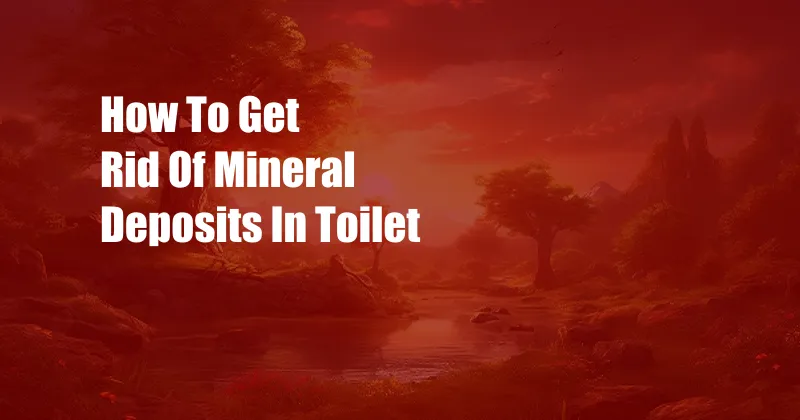
How to Get Rid of Mineral Deposits in Your Toilet: A Comprehensive Guide
Mineral deposits, also known as limescale, can accumulate in your toilet over time, causing unsightly stains and reduced flushing efficiency. Hard water, containing high levels of calcium and magnesium, is the primary culprit behind this issue. If you’re grappling with this problem, fret not! In this article, we’ll delve into the world of mineral deposits, exploring their causes and presenting a comprehensive guide to effectively removing them from your toilet.
Understanding Mineral Deposits
Mineral deposits are formed when minerals dissolved in hard water precipitate out of solution and attach to surfaces. These deposits can be white, gray, or brown in color and often appear as crusty or scaly patches inside the toilet bowl, on the rim, and around the flush valve. As they accumulate, mineral deposits can clog the toilet’s drainage system, leading to slow flushing or even complete blockage.
Prevention and Regular Maintenance
While mineral deposits are a common occurrence in areas with hard water, there are preventive measures you can take to minimize their formation:
- Use a water softener: Installing a water softener in your home can significantly reduce the mineral content of your water, preventing mineral deposits from forming in your toilet and other plumbing fixtures.
- Regular cleaning: Cleaning your toilet regularly helps prevent mineral deposits from accumulating. Use a toilet bowl cleaner specifically designed to remove mineral deposits and follow the manufacturer’s instructions carefully.
- Vinegar treatment: Pour about two cups of white vinegar into the toilet bowl and allow it to sit overnight. The acidity of the vinegar will help dissolve mineral deposits, making them easier to remove.
Effective Removal Methods
If mineral deposits have already accumulated in your toilet, here are some effective methods to remove them:
Chemical Cleaners
Commercial toilet bowl cleaners containing hydrochloric acid or muriatic acid are highly effective in removing mineral deposits. However, these chemicals can be harsh, so it’s crucial to follow the manufacturer’s instructions carefully and ensure adequate ventilation.
Natural Solutions
For a more eco-friendly approach, try using natural solutions such as:
- White vinegar: As mentioned earlier, vinegar’s acidity can dissolve mineral deposits. Pour two cups into the toilet bowl and let it sit for several hours or overnight.
- Baking soda and vinegar: Create a paste by mixing baking soda with a small amount of water. Apply the paste to the mineral deposits and let it sit for at least 30 minutes. Then, pour two cups of vinegar into the toilet bowl and let it bubble and fizz.
- Borax: Dissolve half a cup of borax in a gallon of hot water. Pour the solution into the toilet bowl and let it soak for several hours. The borax will help soften the mineral deposits, making them easier to remove.
Mechanical Removal
For stubborn mineral deposits, you may need to resort to mechanical removal:
- Pumice stone: A pumice stone is a natural abrasive that can be used to gently scrub away mineral deposits. Be careful not to scratch the toilet bowl’s surface.
- Toilet brush: A standard toilet brush can be used to remove loose mineral deposits. Combine it with a commercial toilet bowl cleaner for increased effectiveness.
Tips and Expert Advice
Here are some additional tips and expert advice for removing mineral deposits:
- Regular cleaning: The key to preventing and removing mineral deposits is regular cleaning. Aim to clean your toilet at least once a week, and more frequently if you have hard water.
- Choose the right cleaner: Not all toilet bowl cleaners are created equal. Choose a cleaner specifically designed to remove mineral deposits and follow the manufacturer’s instructions carefully.
- Patience is key: Removing mineral deposits can take time and effort. Don’t be discouraged if the deposits don’t disappear immediately. Keep at it and you’ll eventually see results.
Frequently Asked Questions
- Q: Why is it important to remove mineral deposits?
A: Mineral deposits can clog the toilet’s drainage system, leading to slow flushing or complete blockage. Additionally, they can make your toilet look unsightly and unhygienic. - Q: Can I use bleach to remove mineral deposits?
A: While bleach is a powerful disinfectant, it is not effective at removing mineral deposits. In fact, using bleach can make the deposits worse by causing them to harden.
Conclusion
Mineral deposits in your toilet are a common problem, but with the right knowledge and methods, you can effectively remove them and keep your toilet sparkling clean. Remember, regular cleaning and maintenance are key to preventing mineral deposits from building up in the first place. If you have any further questions, don’t hesitate to reach out to a professional plumber for assistance.
Are you interested in learning more about how to keep your bathroom spotless? Check out our other articles on cleaning and maintaining your bathroom fixtures and surfaces.